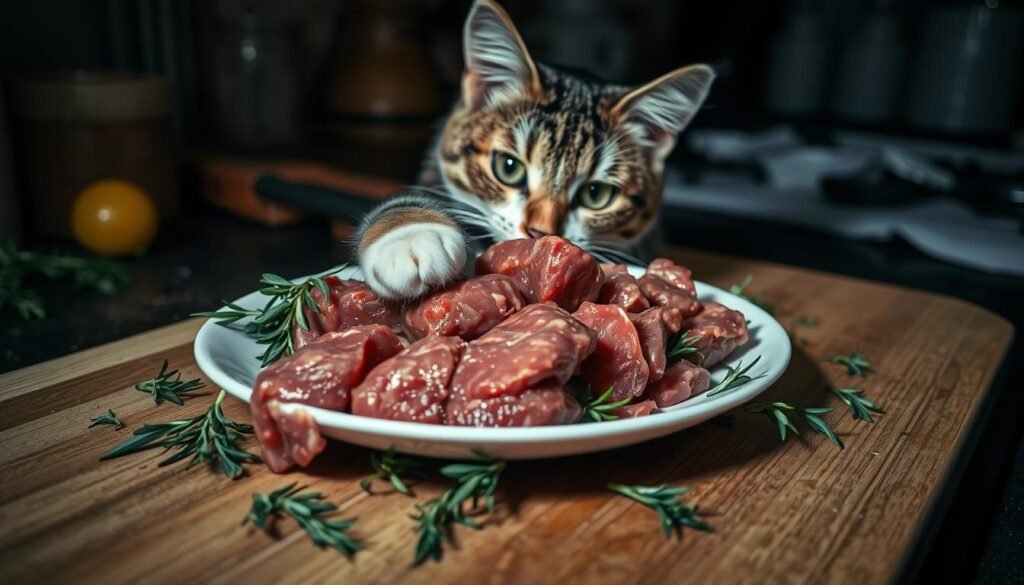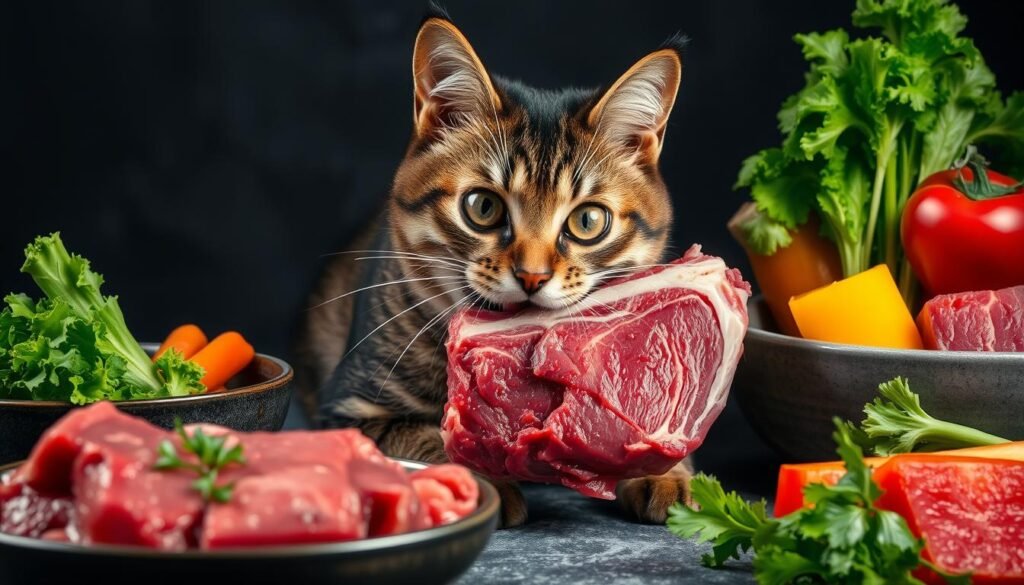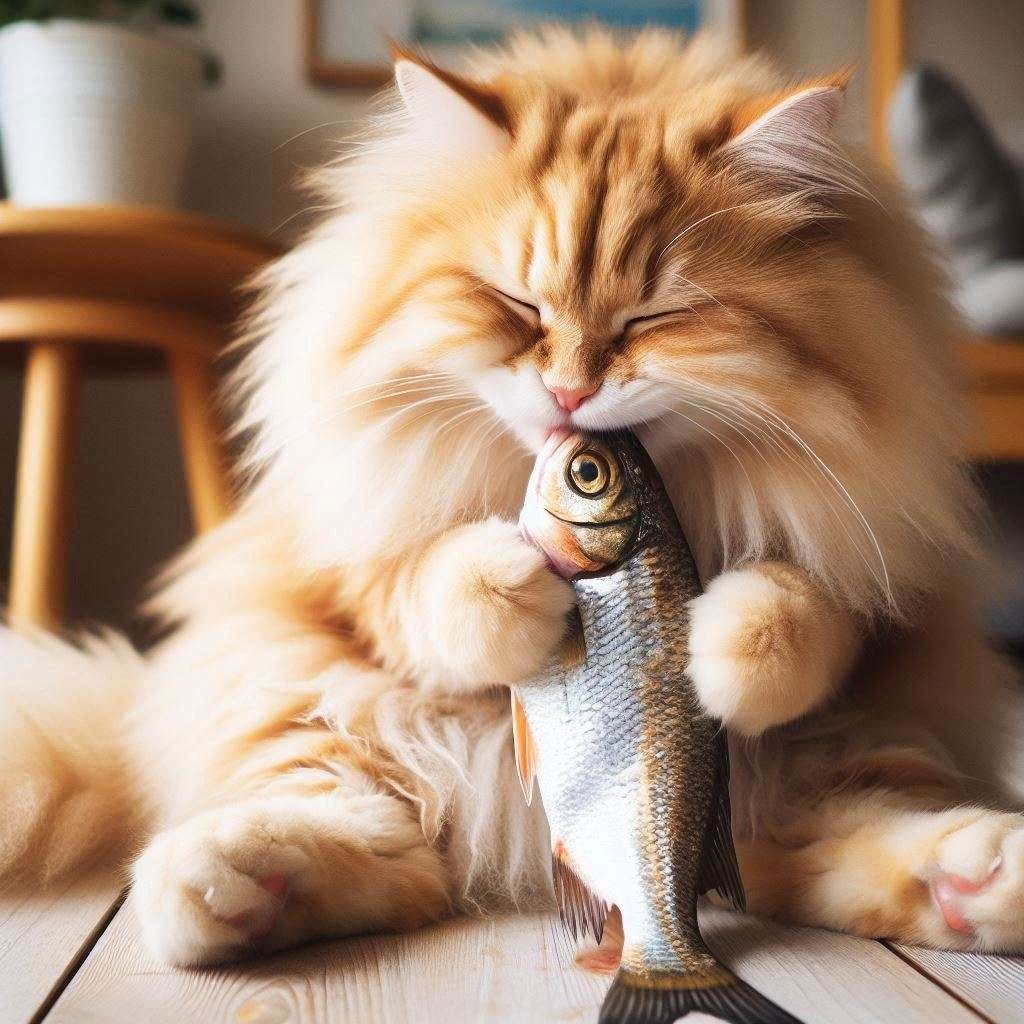Can cats eat raw steak? Many pet owners have debated whether to feed their cats raw meat. Raw cat food includes uncooked meat, raw offal, and bones, along with veggies. It can be homemade or bought, with different types available.
Some believe raw diets help cats eat like their wild ancestors. But, our pets have changed a lot since then. They live longer than wild cats do.

Key Takeaways
- Cats can start eating raw meat from as early as 20 weeks of age.
- Raw diets can provide cats with lower carbohydrates and higher protein content.
- Certain meats like venison, salmon, and duck offer unique nutritional benefits for cats.
- Proper preparation and handling of raw meat is crucial to prevent bacterial contamination.
- Consulting with a veterinarian is recommended when considering a raw diet for your cat.
Introduction to Raw Diets for Cats
Feeding raw meat to cats is a topic of debate among pet owners. A raw diet for cats includes uncooked meat, organs, and sometimes bone. These diets can be homemade or bought, with different types available.
Debate on Feeding Raw Meat to Felines
Some cat owners believe a raw diet is better for their pets. They say it’s more natural and meets a cat’s needs as an obligate carnivore. But, others worry about health risks like bacterial contamination and nutritional imbalances.
What is a Raw Food Diet for Cats?
A raw diet for cats has uncooked muscle and organ meat, and sometimes bone. These come from animals like beef, chicken, turkey, or game. Commercial raw cat food is made to be complete and balanced, following AAFCO guidelines.
| Commercially Prepared Raw Cat Food | Homemade Raw Cat Food |
|---|---|
| Stella & Chewy’s raw cat food contains 98% raw muscle meat, organ meat, and ground bone. | When making homemade raw cat food, it’s essential to use fresh, high-quality meat and avoid previously frozen or spoiled ingredients. |
| Stella & Chewy’s raw cat food formulas are complete and balanced, meeting AAFCO guidelines. | Homemade raw diets allow cat owners to have control over the meat sources, supporting ethical and sustainable practices. |
Switching a cat to a raw diet should be done slowly, over 7-10 days. This helps the cat adjust smoothly.
Potential Benefits of Raw Meat Diets
Feeding raw meat to cats is a topic of discussion, with both sides presenting arguments. Those who support raw meat diet for cats believe it offers a closer to nature diet. They say it mimics the eating habits of wild cats. Some also see it as a safer alternative to store-bought pet food, especially after food recalls.
One good thing about meat-based cat diets is it can bring cats and their owners closer. Giving cats raw food makes owners feel they’re doing what’s right for their pets. This leads to a stronger bond and more care.
“Anecdotal reports suggest that raw beef in a cat’s diet might lead to benefits such as improved coat and skin, better energy levels, and a reduction in certain health issues like parasites and obesity.”
Supporters also think a raw beef for cats diet is more natural. Cats, being obligate carnivores, are meant to eat prey in the wild. This idea of fitting into their natural eating habits is why some pet owners choose raw diets.
Even though the benefits of feline nutrition from raw meat are up for debate, it’s crucial to look at the risks too. Any diet change should be done carefully and with a vet’s advice. This ensures the cat’s health and happiness.
Nutritional Value of Raw Beef for Cats
Raw beef is a great source of protein and nutrients for cats. A 100-gram piece of raw beef has 19 to 30 grams of high-quality protein. It also has water, fats, and a bit of other nutrients.
Cats need a diet full of animal protein to stay healthy. Raw beef is perfect for cats because it has lots of protein. This protein helps with muscle repair and keeping cats healthy. Raw beef also has vitamins and minerals like iron, zinc, and B vitamins. These are important for cats.
| Nutrient | Benefit for Cats |
|---|---|
| Iron | Essential for red blood cell formation and oxygen transport |
| Zinc | Supports cell production, growth, wound healing, and immune system function |
| B Vitamins | Provide essential water-soluble nutrients for overall feline health |
| Taurine | Crucial for vision, heart health, and reproduction in cats |
Raw beef is good for cats but has risks like foodborne illnesses. Always change your cat’s diet slowly and with a vet’s advice. This keeps your cat safe and healthy.
Can Cats Eat Raw Steak?
Cats need a meat-based diet because they are obligate carnivores. Raw steak can be a good protein source for them if given correctly. It has the right mix of protein and fat for cats.
Felines as Obligate Carnivores
Cats have special digestive systems for animal proteins. They can’t use plant-based proteins and carbs well. So, they need a diet full of animal protein and fat.
Protein and Fat Content in Raw Beef
Raw beef, like steak, is packed with good protein and fats for cats. A three-ounce piece of steak has about 178 calories, fitting a cat’s daily needs. It also has important vitamins and minerals like vitamin B12, iron, and selenium for their health.
But, raw meat might have harmful bacteria, so handling and getting it from a trusted source is key. Cooked steak is safer because it kills off bad germs.

“Cats are biologically designed to eat meat daily, while humans are not. Feeding cats steak in moderation can be beneficial, but raw meat should be avoided due to potential bacterial contamination.”
Risks and Concerns of Raw Beef Diets
Raw beef can be a good protein source for cats, but it comes with risks. The main concern is the chance of harmful pathogens like Salmonella and E. coli. These can be dangerous to cats and their owners.
Safety Risks and Contamination
Cats eating raw diets can spread harmful bacteria to humans and other pets. Also, small bones in raw meat can be a choking hazard for cats. It’s important to handle and store raw ingredients safely to avoid contamination.
Other Health Risks
Raw beef diets have other health risks for cats too. Cats allergic to beef should not eat it, as it can cause a bad reaction. Also, a raw diet that’s not balanced can lead to health problems.
Nutritional Risks
Cats need more calcium than humans, and raw meat alone might not give them enough. Studies show that cats on all-meat diets have weaker bones after just 10 weeks. Kittens are especially at risk of health issues from a diet low in calcium.
For a safe and healthy raw beef diet for cats, talk to a vet. Make sure the diet meets your cat’s nutritional needs. Handling, storing, and preparing raw meat safely is also key to avoiding risks.
Safely Feeding Raw Beef to Cats
If you’re thinking about adding raw beef to your cat’s diet, make sure to do it safely. First, find high-quality, safe raw ingredients.
Sourcing Raw Ingredients
Look for raw beef from trusted places that have health and safety approvals. Keep up with any recalls and throw away affected products right away.
Monitoring Reactions and Portions
Start with small amounts of raw beef and watch your cat for any bad reactions. If they seem okay, you can give them a bit more. It’s important to keep an eye on how much protein and nutrients they get.
By doing this, you can safely add raw beef to your cat’s diet. Remember, choose quality ingredients, go slow, and watch how they react and how much they eat.
Other Beef Parts for Cats
Raw beef is a great protein source for cats, but there are other beef parts that are safe too. Beef organs are especially good for cats. They give cats important nutrients that help with their health and well-being.
Organs and Their Safety
Beef liver is a top choice for cats. It’s full of vitamin A, which is key for their vision, skin, and immune system. Feeding them 5% of their daily diet as beef liver is safe and good for them.
But, watch how your cat reacts to organ meats. They can have a lot of nutrients that might be bad if eaten too much. Too much can cause vitamin A poisoning or other health problems. So, add these foods slowly and in small amounts.
Other organs like heart and kidneys are also safe for cats. But, talk to your vet first. They can tell you how much and how often to feed them based on your cat’s health and needs.
“Introducing organ meats to your cat’s diet can be a great way to boost their nutrient intake, but it’s crucial to do so with caution and under the guidance of your veterinarian.”
Transitioning to a Raw Diet
Starting a raw meat diet for cats needs patience and careful watching. Cats might be slow to accept a change from their usual kibble or wet food to a cat raw meat diet. It’s key to make the switch step by step.
Begin by adding just 10% raw food to your cat’s diet. This helps ease any stomach upset as they get used to raw feeding for felines. Cats that have eaten the same thing for a long time might not see raw meat as food at first. So, keep trying and don’t give up.
Experts say cats do best when fed proteins like Mystic Chicken, Chicken with Salmon Vibes, Magic Rabbit, and Wonder Turkey. Adding new proteins slowly helps your cat get used to meat-based cat diets and natural cat diets.
As your cat gets used to the new diet, you might see changes in their poop. It could be softer, look different, or have different colors. Sometimes, they might even skip a bowel movement or two. These changes are normal as their body adjusts to raw feeding for felines.
Every cat is different, and how fast they adjust to a raw diet varies. Don’t rush the process and let your cat set the pace. With patience and advice from your vet, you can help your cat move to a healthy cat raw meat diet.

Alternative Options and Compromise
For pet owners unsure about a raw meat diet for their cats, there are other choices. You could mix raw beef with a top-notch, low-carb dry cat food. This way, cats get the good stuff from raw meat-based diets but avoid the full diet’s risks.
Another idea is to give raw meat as a special treat, not the main food. Adding some raw meat to their diet lets owners offer benefits while still meeting their cat’s nutritional needs.
| Benefits of Compromised Raw Meat Diets | Considerations for Compromised Raw Meat Diets |
|---|---|
|
|
Feeding cats raw steak or other raw meat needs careful thought and some compromise. By looking at these other options, pet owners can give their cats the good parts of a meat-based cat diet safely.
Conclusion
Feeding raw beef to cats is a topic that sparks debate. On one hand, it can offer protein and nutrients. But, it’s important to think about safety concerns like contamination and health risks. Always talk to your vet before adding raw beef to your cat’s diet, considering their needs and your ability to handle raw ingredients.
Knowing the pros and cons helps you decide if raw beef is good for your cat. Meat-based cat diets and natural cat diets have their benefits. Yet, safety must come first when thinking about raw meat diet for cats or can cats eat raw steak. With careful planning and expert advice, you can meet your cat’s feline nutrition needs safely and healthily.
Deciding to add raw beef or other raw meat to your cat’s diet should be a thoughtful choice. Talk to your vet and keep your cat’s health in mind. This way, you can make the best choice for their well-being and happiness.


